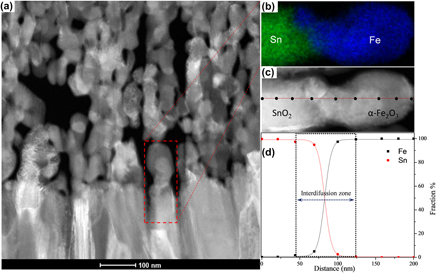Crossref Citations
This article has been cited by the following publications. This list is generated based on data provided by
Crossref.
Mariño-Otero, T.
Oliver-Tolentino, M.A.
Aguilar-Frutis, M.A.
Contreras-Martínez, G.
Pérez-Cappe, E.
and
Reguera, E.
2015.
Effect of thickness in hematite films produced by spray pyrolysis towards water photo-oxidation in neutral media.
International Journal of Hydrogen Energy,
Vol. 40,
Issue. 17,
p.
5831.
Freitas, André L.M.
Carvalho, Waldemir M.
and
Souza, Flavio L.
2015.
Enhanced water oxidation efficiency of hematite thin films by oxygen-deficient atmosphere.
Journal of Materials Research,
Vol. 30,
Issue. 23,
p.
3595.
Zandi, Omid
Schon, Abraham R.
Hajibabaei, Hamed
and
Hamann, Thomas W.
2016.
Enhanced Charge Separation and Collection in High-Performance Electrodeposited Hematite Films.
Chemistry of Materials,
Vol. 28,
Issue. 3,
p.
765.
Carvalho-Jr, Waldemir M.
and
Souza, Flavio L.
2016.
Thermal enhancement of water affinity on the surface of undoped hematite photoelectrodes.
Solar Energy Materials and Solar Cells,
Vol. 144,
Issue. ,
p.
395.
Soares, Mario R. S.
Gonçalves, Ricardo H.
Nogueira, Içamira C.
Bettini, Jefferson
Chiquito, Adenilson J.
and
Leite, Edson R.
2016.
Understanding the fundamental electrical and photoelectrochemical behavior of a hematite photoanode.
Physical Chemistry Chemical Physics,
Vol. 18,
Issue. 31,
p.
21780.
do Amaral Carminati, Saulo
Souza, Flavio L.
and
Nogueira, Ana F.
2016.
Enhancing Hematite Photoanode Activity for Water Oxidation by Incorporation of Reduced Graphene Oxide.
ChemPhysChem,
Vol. 17,
Issue. 1,
p.
170.
Ito, Nathalie Minko
Carvalho, Waldemir Moura
Muche, Dereck Nills Ferreira
Castro, Ricardo Hauch Ribeiro
Dalpian, Gustavo Martini
and
Souza, Flavio Leandro
2017.
High temperature activation of hematite nanorods for sunlight driven water oxidation reaction.
Physical Chemistry Chemical Physics,
Vol. 19,
Issue. 36,
p.
25025.
Freitas, Andre L M
and
Souza, Flavio L
2017.
Synergetic effect of Sn addition and oxygen-deficient atmosphere to fabricate active hematite photoelectrodes for light-induced water splitting.
Nanotechnology,
Vol. 28,
Issue. 45,
p.
454002.
Primc, Darinka
Bärtsch, Mario
Barreca, Davide
Carraro, Giorgio
Maccato, Chiara
Sada, Cinzia
and
Niederberger, Markus
2017.
Doping of TiO2as a tool to optimize the water splitting efficiencies of titania–hematite photoanodes.
Sustainable Energy & Fuels,
Vol. 1,
Issue. 1,
p.
199.
Souza, Flavio L
and
Leite, Edson R
2018.
Nanoenergy.
p.
141.
Muche, Dereck N.F.
dos Santos, Thayna M.G.
Leite, Gabriela P.
Melo, Mauricio A.
Gonçalves, Renato V.
and
Souza, Flavio L.
2019.
Tailoring hematite/FTO interfaces: New horizons for spin-coated hematite photoanodes targeting water splitting.
Materials Letters,
Vol. 254,
Issue. ,
p.
218.
Bandi, Suresh
Hastak, Vikram
Pavithra, Chokkakula L.P.
Kashyap, Sanjay
Singh, Dhananjay Kumar
Luqman, Suaib
Peshwe, Dilip R.
and
Srivastav, Ajeet K.
2019.
Graphene/chitosan-functionalized iron oxide nanoparticles for biomedical applications.
Journal of Materials Research,
Vol. 34,
Issue. 20,
p.
3389.
Amaral Carminati, Saulo
do Nascimento Barbosa, André
Luiz Martins de Freitas, Andre
Freire, Fernando Lázaro
Souza, Flávio Leandro
and
Nogueira, Ana Flávia
2019.
Unraveling the role of single layer graphene as overlayer on hematite photoanodes.
Journal of Catalysis,
Vol. 372,
Issue. ,
p.
109.
Bedin, Karen C.
Freitas, Andre L. M.
Tofanello, Aryane
Rodríguez‐Gutiérrez, Ingrid
and
Souza, Flavio L.
2020.
Revealing the synergy of Sn insertion in hematite for next‐generation solar water splitting nanoceramics.
International Journal of Ceramic Engineering & Science,
Vol. 2,
Issue. 5,
p.
204.
Freitas, Andre L. M.
Muche, Dereck N. F.
Leite, Edson R.
and
Souza, Flavio L.
2020.
Interface engineering of nanoceramic hematite photoelectrode for solar energy conversion.
Journal of the American Ceramic Society,
Vol. 103,
Issue. 12,
p.
6833.
Kment, Š.
Sivula, K.
Naldoni, A.
Sarmah, S.P.
Kmentová, H.
Kulkarni, M.
Rambabu, Y.
Schmuki, P.
and
Zbořil, R.
2020.
FeO-based nanostructures and nanohybrids for photoelectrochemical water splitting.
Progress in Materials Science,
Vol. 110,
Issue. ,
p.
100632.
Freitas, Andre L. M.
Tofanello, Aryane
Souza, Flavio L.
and
Li, Yat
2021.
Insights on Thickness-Dependent Charge Transfer Efficiency Modulated by Ultrasonic Treatment in Hematite Photoanodes.
The Journal of Physical Chemistry C,
Vol. 125,
Issue. 18,
p.
9981.
Rodríguez-Gutiérrez, Ingrid
Mouriño, Beatriz
Freitas, André L. M.
Costa, Carlos A. R.
Pires, Elcio L
Gonçalves, Renato V.
Vayssieres, Lionel
and
Souza, Flavio L.
2022.
On the Effect of Thermal Processing on Sn Diffusion and Efficiency Enhancement in Hematite/FTO Photoanodes.
ECS Journal of Solid State Science and Technology,
Vol. 11,
Issue. 4,
p.
043001.
Tanvir, Fouzia
Sardar, Nimra
Yaqub, Atif
and
Ditta, Sarwar Allah
2022.
Synthesis of iron oxide nanoparticles, characterization, uses as nanozyme and future prospects.
Bioinspired, Biomimetic and Nanobiomaterials,
Vol. 11,
Issue. 4,
p.
156.
Garg, Parveen
Mohapatra, Lokanath
Poonia, Ajay Kumar
Kushwaha, Ajay Kumar
Adarsh, Kumaran Nair Valsala Devi
Sarker, Debalaya
and
Deshpande, Uday
2024.
Highly [210] Oriented Porous α-Fe2O3/Fe3O4/ Fe Mesocrystalline Photoanode for Efficient Water Splitting.
The Journal of Physical Chemistry C,
Vol. 128,
Issue. 44,
p.
18736.
